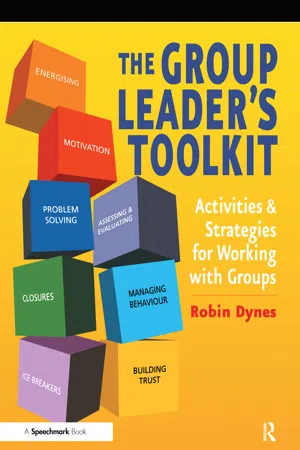
- 192 pages
- English
- ePUB (mobile friendly)
- Available on iOS & Android
About This Book
An essential resource for all kinds of groups, these tried and tested strategies will stimulate and encourage full participation from all group members. Provides ideas for introducing group members to each other, breaking down barriers, energising people, helping people learn, moving the group on, building trust between group members, motivating people, assessing and evaluating the group, managing behaviour and personal responsibility, and ending sessions. The activities are set out in a clear, easy to follow format, with variations and guidance for adapting the activities. Will enable group leaders to promote group members' self development, meet the needs of their different learning styles, stimulate their creativity and develop their thinking skills. This toolkit is an invaluable resource for tutors, occupational therapists, nurses, care staff, probation staff, youth leaders or anyone - new or experienced - who works with groups.
Frequently asked questions
Information

Introductions and icebreakers
- Famous people
- Word association
- Personal possessions
- Goofy questions
- Fears and hopes
- Getting acquainted
- Things I like
- Assets I bring
- Memory game
- Animals
- Question time
- Who I relate to
- Find the person
- Preferences
- Birthplace
Famous people
- To help participants get to know each other

- To identify influences on beliefs

- To enable people to feel at ease and start making disclosures

- To have fun

PREPARATION materials needed
THE ACTIVITY
VARIATION
COMMENT
USE ALSO FOR
Word association
- To help group members get to know each other better

- To begin building trust

- To encourage self-disclosure

PREPARATION materials needed
THE ACTIVITY
VARIATION
COMMENT
USE ALSO FOR
Personal possessions
Table of contents
- Cover
- Title Page
- Copyright Page
- Contents
- List of resources
- The Group Leader’s Toolkit Activities listed by theme
- Preface
- Acknowledgements
- Introduction
- THE TOOLKIT
- Bibliography